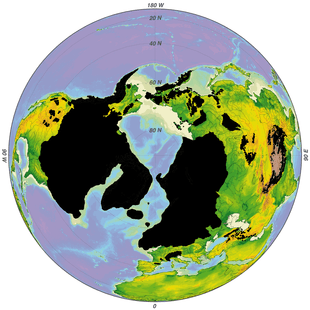Huronian glaciation
The Huronian glaciation (or Makganyene glaciation)[1] was a glaciation that extended from 2.4 billion years ago (Gya) to 2.1 Gya, during the Siderian and Rhyacian periods of the Paleoproterozoic era. The Huronian glaciation followed the Great Oxygenation Event (GOE), a time when increased atmospheric oxygen decreased atmospheric methane. The oxygen combined with the methane to form carbon dioxide and water, which do not retain heat as well as methane does. The glaciation led to a mass extinction on Earth.
Discovery and name
In 1907, Arthur Philemon Coleman first inferred a "lower Huronian ice age"[2][3] from analysis of a geological formation near Lake Huron. This formation consists of two non-glacial sediment deposits found between three horizons of glacial deposits of the Huronian Supergroup, deposited between 2.5 and 2.2 billion years ago.[4]
Other evidence
The Gowganda formation (2.3 Ga) contains "the most widespread and most convincing glaciogenic deposits of this era", according to Eyles and Young. Similar deposits are found in Michigan (2.1–2 Ga), the Black Hills (2.6–1.6 Ga), Chibougamau, Canadian Northern Territories (2.1 Ga) and Wyoming. Similar age deposits occur in the Griquatown Basin (2.3 Ga), India (1.8 Ga) and Australia (2.5—2.0 Ga).[4]
Geological context
The tectonic setting was one of a rifting continental margin. New continental crust would have resulted in chemical weathering. This weathering would pull CO2 out of the atmosphere, cooling the planet through the reduction in greenhouse effect.
Causes and effects
Before the Huronian Ice Age, most organisms were anaerobic, but around this time, the cyanobacteria evolved oxygenic photosynthesis. These bacteria were able to reproduce at exponential rates due to their new ecological niche, exploiting the abundant energy of the sunlight. Their photosynthesis produced oxygen as a waste product expelled into the air. At first, most of this oxygen was absorbed through the oxidation of surface iron and the decomposition of life forms. However, as the population of the cyanobacteria continued to grow, these oxygen sinks became saturated.[5]
As oxygen "polluted" the mostly methane atmosphere, a mass extinction occurred of most life forms, which were anaerobic and to whom oxygen was toxic. Methane turned from dominant in the atmosphere to a trace gas, as it was oxidized into carbon dioxide and water. A different atmosphere emerged which was thinner, with less powerful greenhouse gases. Earth's temperature dropped, partly because solar luminosity was lower at that time so the Earth was more vulnerable to a decline in greenhouse gases. The Huronian Ice Age is thought to be the first time Earth was completely covered in ice, and to have practically stopped photosynthesis.
See also
References
- Tang, Haoshu; Chen, Yanjing (1 September 2013). "Global glaciations and atmospheric change at ca. 2.3 Ga". Geoscience Frontiers. 4 (5): 583–596. doi:10.1016/j.gsf.2013.02.003.
- Coleman, A. P. (1 March 1907). "A lower Huronian ice age". American Journal of Science. s4-23 (135): 187–192. doi:10.2475/ajs.s4-23.135.187. ISSN 0002-9599.
- Bekker, Andrey (2014). "Huronian Glaciation". Encyclopedia of Astrobiology. pp. 1–8. doi:10.1007/978-3-642-27833-4_742-4. ISBN 978-3-642-27833-4.
- Eyles, Nicholas; Young, Grant (1994). Deynoux, M.; Miller, J.M.G.; Domack, E.W.; Eyles, N.; Fairchild, I.J.; Young, G.M. (eds.). Geodynamic controls on glaciation in Earth history, in Earth's Glacial Record. Cambridge: Cambridge University Press. pp. 3–5. ISBN 978-0-521-54803-8.
- Kopp, Robert (14 June 2005). "The Paleoproterozoic snowball Earth: A climate disaster triggered by the evolution of oxygenic photosynthesis". PNAS. 102 (32): 11131–6. doi:10.1073/pnas.0504878102. PMC 1183582. PMID 16061801.
